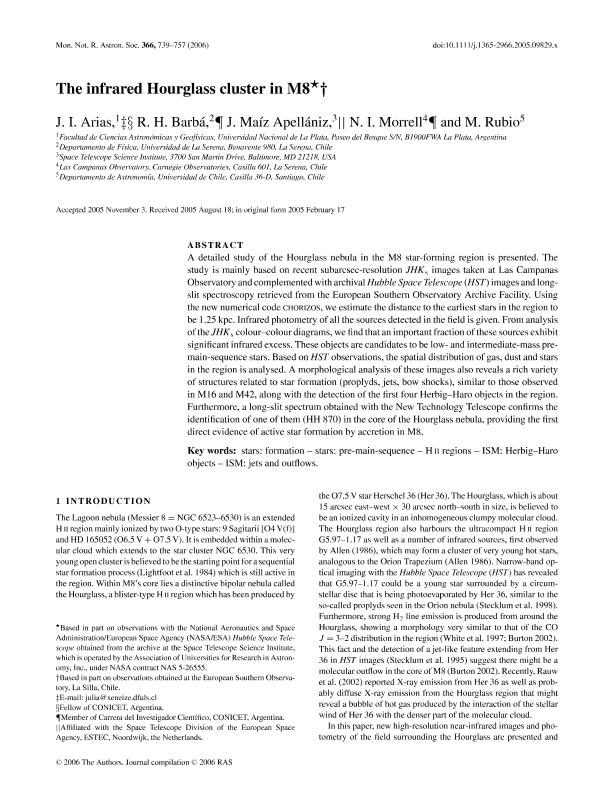Mostrar el registro sencillo del ítem
dc.contributor.author
Arias, Julia Ines

dc.contributor.author
Barba, Rodolfo Hector

dc.contributor.author
Maíz Apellániz, J.
dc.contributor.author
Morrell, Nidia Irene

dc.contributor.author
Rubio, M.
dc.date.available
2018-03-07T20:59:00Z
dc.date.issued
2006-03
dc.identifier.citation
Arias, Julia Ines; Barba, Rodolfo Hector; Maíz Apellániz, J.; Morrell, Nidia Irene; Rubio, M.; The infrared Hourglass cluster in M8; Oxford University Press; Monthly Notices of the Royal Astronomical Society; 366; 3; 3-2006; 739-757
dc.identifier.issn
0035-8711
dc.identifier.uri
http://hdl.handle.net/11336/38213
dc.description.abstract
A detailed study of the Hourglass nebula in the M8 star-forming region is presented. The study is mainly based on recent subarcsec-resolution JHK s images taken at Las Campanas Observatory and complemented with archival Hubble Space Telescope (HST) images and long-slit spectroscopy retrieved from the European Southern Observatory Archive Facility. Using the new numerical code chorizos, we estimate the distance to the earliest stars in the region to be 1.25 kpc. Infrared photometry of all the sources detected in the field is given. From analysis of the JHKs colour-colour diagrams, we find that an important fraction of these sources exhibit significant infrared excess. These objects are candidates to be low- and intermediate-mass pre-main-sequence stars. Based on HST observations, the spatial distribution of gas, dust and stars in the region is analysed. A morphological analysis of these images also reveals a rich variety of structures related to star formation (proplyds, jets, bow shocks), similar to those observed in M16 and M42, along with the detection of the first four Herbig-Haro objects in the region. Furthermore, a long-slit spectrum obtained with the New Technology Telescope confirms the identification of one of them (HH 870) in the core of the Hourglass nebula, providing the first direct evidence of active star formation by accretion in M8.
dc.format
application/pdf
dc.language.iso
eng
dc.publisher
Oxford University Press

dc.rights
info:eu-repo/semantics/openAccess
dc.rights.uri
https://creativecommons.org/licenses/by-nc-sa/2.5/ar/
dc.subject
H Ii Regions
dc.subject
Ism: Herbig-Haro Objects
dc.subject
Ism: Jets And Outflows
dc.subject
Stars: Formation
dc.subject
Stars: Pre-Main-Sequence
dc.subject.classification
Astronomía

dc.subject.classification
Ciencias Físicas

dc.subject.classification
CIENCIAS NATURALES Y EXACTAS

dc.title
The infrared Hourglass cluster in M8
dc.type
info:eu-repo/semantics/article
dc.type
info:ar-repo/semantics/artículo
dc.type
info:eu-repo/semantics/publishedVersion
dc.date.updated
2018-03-06T15:14:34Z
dc.journal.volume
366
dc.journal.number
3
dc.journal.pagination
739-757
dc.journal.pais
Reino Unido

dc.journal.ciudad
Oxford
dc.description.fil
Fil: Arias, Julia Ines. Universidad Nacional de la Plata. Facultad de Ciencias Astronómicas y Geofísicas; Argentina. Consejo Nacional de Investigaciones Científicas y Técnicas; Argentina
dc.description.fil
Fil: Barba, Rodolfo Hector. Universidad de La Serena; Chile. Consejo Nacional de Investigaciones Científicas y Técnicas; Argentina
dc.description.fil
Fil: Maíz Apellániz, J.. Space Telescope Science Institute; Estados Unidos
dc.description.fil
Fil: Morrell, Nidia Irene. Las Campanas Observatory; Chile. Consejo Nacional de Investigaciones Científicas y Técnicas; Argentina
dc.description.fil
Fil: Rubio, M.. Universidad de Chile; Chile
dc.journal.title
Monthly Notices of the Royal Astronomical Society

dc.relation.alternativeid
info:eu-repo/semantics/altIdentifier/doi/http://dx.doi.org/10.1111/j.1365-2966.2005.09829.x
dc.relation.alternativeid
info:eu-repo/semantics/altIdentifier/url/https://academic.oup.com/mnras/article/366/3/739/992534
Archivos asociados
